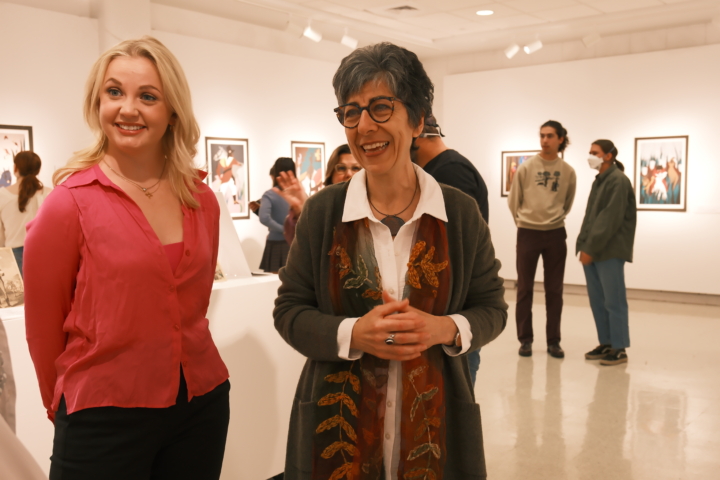An artful experience
It may look effortless, but any beautifully organized museum exhibit involves a lot of elbow grease and creative challenges on the way to its opening.
Just ask the 15 students in The Curatorial Project, an art history class at William & Mary, who this fall designed and delivered an exhibit of 15 silkscreened prints by one of the leading figurative artists of the 20th century — Jacob Lawrence.
“Haiti to Harlem” is on display through Nov. 22 at the Andrews Gallery, 605 Jamestown Rd. It’s another event open to the public in celebration of William & Mary’s Year of the Arts. Admission is free. The gallery is open from 10 a.m. to 4 p.m., Monday through Friday.
“They had 10 weeks from concept to installation and, believe me, it usually takes much longer than that, months, if not years,” said Sibel Zandi-Sayek, associate professor of art history. Her students made it happen by splitting themselves into three teams: editorial, digital, and spatial.

The editorial team wrote didactic panels and expanded labels for the installation and text for the brochure, posters, and related media. “It’s different than other writing,” said Anne Paxton ’25. “You need absolute command of the material because it has to be concise, you have to boil it down, and because these captions are going to guide people through the exhibit.”
The spatial team designed the layout of the prints and the ancillary materials. “I did not realize how much math would be involved,” said Nia Dowling ’26.
The website team made sure the project would reach outside campus by making the class’s work available online. Zandi-Sayek hopes that it will be up and running by the end of the semester.
“To take a class like this is just a huge gift,” said Talia Kriegel ’26. “I never expected as an undergraduate to get a ‘real world’ experience like this. It shows just how much support William & Mary provides their undergraduates.”
Now add this twist: Late in the process, the students had to rethink the entire exhibit when they learned construction delays would mean a venue change. What was scheduled to be showcased in the newly renovated Muscarelle Museum of Art would instead be mounted three weeks earlier in Andrews Gallery.
“We had to pivot pretty quickly but the whole class came together to brainstorm, and we got it done,” said Dowling ’26.
The prints provide a visual narrative of the life of Toussaint L’Ouverture and his role in the Haitian Revolution, a battle by Haitians to overthrow their French colonizers.
L’Ouverture was born Francois-Dominique Toussaint in Haiti in 1743. He was enslaved there on a plantation until he was freed at age 33. When revolution against France broke out in 1791, Toussaint, by then a general in the Haitian military, took the surname L’Ouverture – French for “the opening” – and became the revolution’s leader.
Lawrence (1917-2000) rose to prominence in the 1940s as one of the first Black artists represented by a major art dealer when his Migration Series was exhibited at New York’s Downtown Gallery. He had long been interested in L’Ouverture, having in the 1930s created a 41-panel tempera painting series detailing L’Ouverture’s life. Half a century later, after studying with prominent Black printmaker Lou Stovall, he created more stylized silkscreen versions of his paintings, playing with patterns that evoke the language of protest art.
“I loved learning the history of Jacob Lawrence,” said Andre Adams ’25. “Before this class, I didn’t know almost anything about him.”
The silkscreens were acquired by the Muscarelle in late 2022 and have never been on display in the museum. Next semester, the exhibit will migrate to the renovated museum, now expected to open in February.
Latest W&M News
- 2024 Chesapeake Bay dead zone near average size but shorter durationThe 2024 Chesapeake Bay Dead Zone Report Card suggests hypoxia in the Chesapeake Bay was somewhat larger than the long-term average from 1985-2023 but slightly shorter in duration.
- 1693 Scholars Program celebrates 20 years of community, curiosityThe 1693 Scholars Program celebrates its 20th anniversary this year, honoring two decades of dedicated faculty mentoring, research support and programming.
- Harvard Medical School honors W&M biology professorThe award recognizes Mayank Chugh’s research contributions and community-building work.
- William & Mary remains No. 1 public university for study abroadW&M also earns the Open Doors 75 Seal of Excellence.
- Current models may overestimate future bay dead zonesA study has demonstrated surprising variability in the results of different modeling methodologies for predicting future dead zones in the Chesapeake Bay.
- W&M chemistry students win awards at national conferenceThe William & Mary chapter of the National Organization for the Professional Advancement of Black Chemists and Chemical Engineers won six awards at the 51st annual NOBCChE National Conference.













